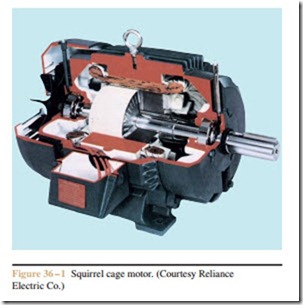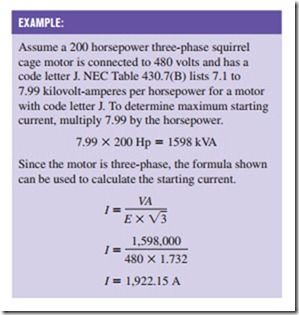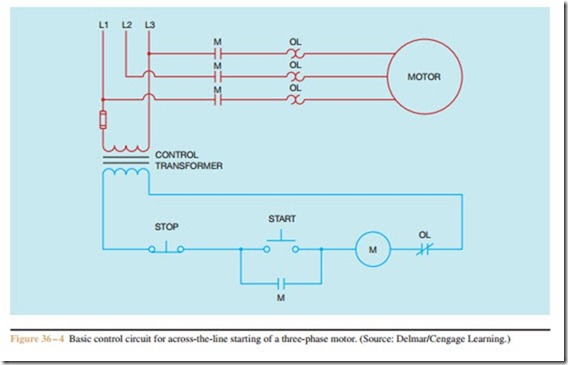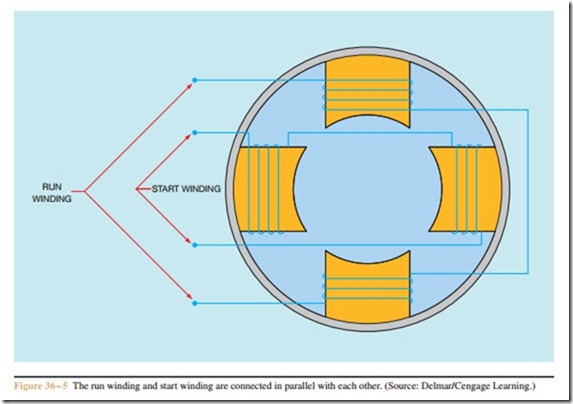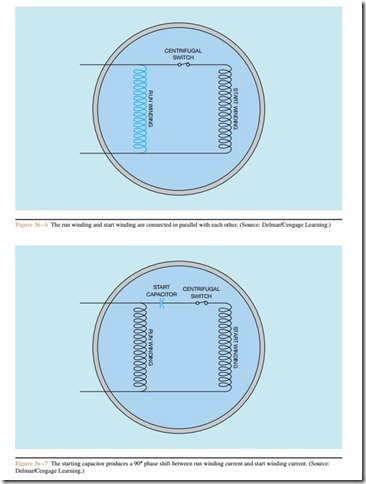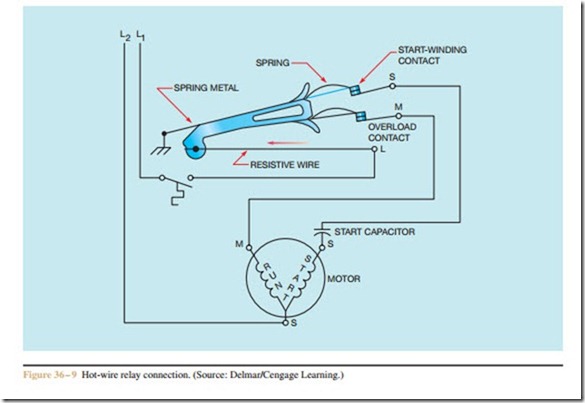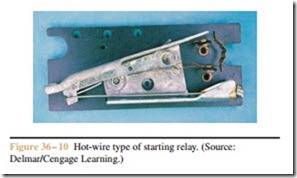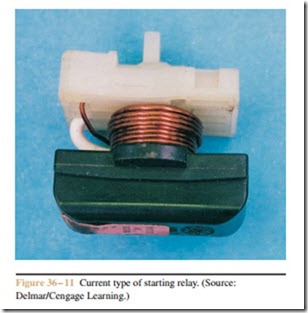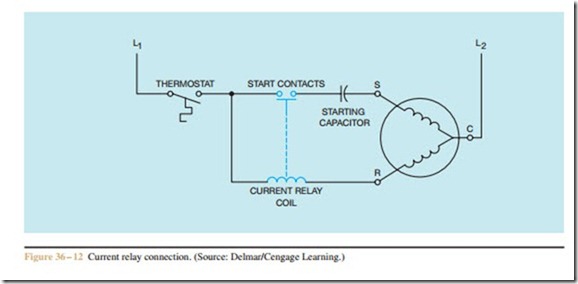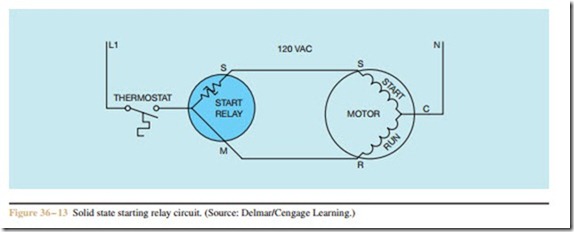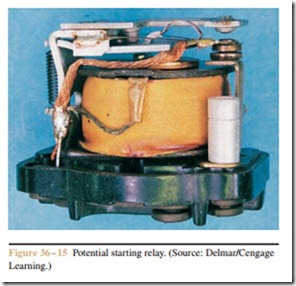Three-phase squirrel cage motors are the most popular motors used in industry. They can range in size from fractional horsepower to thousands of horsepower. Squirrel cage type motors receive their name from the type of rotor (rotating member) installed in the motor. The rotor of a squirrel cage motor appears to be a metal cylinder with a shaft through the middle (Figure 36 – 1). If the laminations were removed, it would be seen that the rotor is actually constructed by connecting metal bars together at each end (Figure 36 – 2). The type of bars used to construct the rotor has a great effect on the operating characteristics of the motor. The type of rotor is identified by a code letter on the nameplate of a motor. Code letters range from A through V. Table 430.7(B) of the National Electrical Code (NEC) lists these code letters, Figure 36 – 3.
It may be necessary sometimes to determine the amount of in-rush current when installing a motor, especially in areas where the power company limits the amount of current it supplies. In-rush current is
referred to as locked rotor current, because it is the amount of current that would flow if the rotor were locked so it could not turn and then the power was turned on. To determine in-rush current for a squirrel cage motor, find the code letter on the motor nameplate. Do not confuse the rotor code letter with the NEMA code letter found on many motors. The nameplate will generally state one as CODE and the other as NEMA CODE. Once the code letter has been deter- mined, it is possible to calculate the starting current for the motor.
Across-the-line starting is the simplest of all starting methods. It is accomplished by connecting the motor directly to the power line. The size of motor that can be started across the line can vary from one area to an- other, depending on the power limitations of the electrical service. In heavily industrialized areas, motors of over one thousand horsepower are often started across the line. In other areas, motors of less than one hundred horsepower may require some type of starter that limits the amount of starting current. A simple across-the-line starting circuit for a three-phase AC motor is shown in Figure 36 – 4.
Large horsepower motors often require an amount of starting current that exceeds the limitations of the power system. When this is the case, some method of reducing the in-rush current must be provided. Some common methods of reducing in-rush current are:
• Resistor or reactor starting
• Autotransformer starting
• Wye-delta starting
• Part winding starting
These methods will be discussed in greater detail later in this text. It should be noted that when voltage or current is reduced during starting, the torque is also reduced. If the voltage is reduced by 50%, the current will be reduced by 50% also, but the starting torque will be re- duced to 25% of the amount developed when the motor is started with full voltage applied to the motor.
Starting Methods for Single-Phase Motors
Starting methods for single-phase motors involve disconnecting the start winding of a split-phase motor when the motor reaches about 75% of its rated speed, as opposed to how the motor is connected to the power line. Single-phase motors are small horsepower and almost all are started across the line. There are several different types of single-phase motors. The motors described in this chapter are the split-phase type.
Split-phase motors derive their name from the manner in which they produce a rotating magnetic field in the stator winding. A rotating magnetic field is used to start the rotor turning and cannot be produced with a single phase. At least two phases must be present to pro- duce a rotating field. Split-phase motors simulate the currents of a two-phase system, which are 90° out of phase with each other. This is accomplished by placing two separate windings in the core of the stator 90° apart, Figure 36 – 5. The run winding is made of larger wire and is placed deeper in the slots of the core material. The start winding is made with smaller wire and placed near the top of the slots in the core material. The run winding, therefore, has less resistance and more induc- tance than the start winding.
When the motor is started, these two windings are connected in parallel, Figure 36 – 6. Since the run winding has more inductive reactance and less resis- tance than the start winding, the current flow through the run winding lags the voltage more than the current flow through the start winding, producing an out of phase condition for these two currents. It is this out of phase condition that produces the rotating magnetic field. This type of split-phase motor is called a resistance start motor and produces a phase angle of about 35° to 40° between the current in the run winding and the current in the start winding. Although this phase
angle is not 90°, it is enough to produce a rotating mag- netic field to start the motor. When the rotor reaches about 75% of its rated speed, the start winding is dis- connected and the motor continues to operate with only the run winding energized.
Although the resistance start motor will start with only a 35° to 40° phase shift between run winding current and start winding current, it produces a weak starting torque. Maximum starting torque is obtained when the run winding and start winding currents are 90° out of phase with each other. Some motors accomplish this by inserting an AC electrolytic capacitor in series with the start winding (Figure 36 – 7). The capacitive reactance of the capacitor causes the start winding current to lead the voltage and produce a 90° phase shift between the run-winding current and start winding current.
Regardless of which method is used to produce the rotating magnetic field, the start winding of either motor must be disconnected from the power line when the rotor reaches about 75% of its rated speed. Failure to do so would result in damage to the start winding.
Centrifugal Switch
Split-phase motors intended to operate in the open accomplish this by the use of a centrifugal switch connected to the shaft of the rotor (Figure 36 – 8). The centrifugal switch is operated by spring loaded counter- weights. When the rotor reaches a certain speed, the counterweights overcome the springs and open the switch, disconnecting the start winding from the power line.
Hot-Wire Starting Relay
Centrifugal switches cannot be used on all types of split-phase motors, however. Hermetically sealed motors used in refrigeration and air conditioning, or submerged pump motors must use some other means to disconnect the start winding. Although the hot-wire relay is seldom used anymore, it is found on some older units that are still in service. The hot-wire relay functions as both a starting relay and an overload relay. In the circuit shown in Figure 36 – 9, it is assumed that
a thermostat controls the operation of the motor. When the thermostat closes, current flows through a resistive wire and two normally closed contacts connected to the start and run windings of the motor. The starting current of the motor is high, which rapidly heats the resistive wire, causing it to expand. The expansion of the wire causes the spring loaded start winding contact to open and disconnect the start winding from the circuit, reducing the motor current. If the motor is not overloaded, the resistive wire never becomes hot enough to cause the overload contact to open, and the motor continues to run. If the motor should become overloaded, however, the resistive wire will expand enough to open the overload contact and disconnect the motor from the line (Figure 36 – 10).
Current Relay
The current relay operates by sensing the amount of current flow in the circuit. This type of relay operates on the principle of a magnetic field instead of expanding metal. The current relay contains a coil with a few turns of large wire and a set of normally open contacts (Figure 36 – 11). The coil of the relay is connected in series with the run winding of the motor, and the contacts are connected in series with the start winding, as shown in Figure 36 – 12. When the thermostat contact closes, power is applied to the run
winding of the motor. Since the start winding is open, the motor cannot start. This causes a high current to flow in the run-winding circuit. This high current flow produces a strong magnetic field in the coil of the relay, causing the normally open contacts to close and con- nect the start winding to the circuit. When the motor starts, the run winding current is greatly reduced, per- mitting the start contacts to reopen and disconnect the start winding from the circuit.
Solid-State Starting Relay
The solid-state starting relay is rapidly replacing the current starting relay. The solid-state relay uses a solid-state component called a thermistor, and therefore has no moving parts or contacts to wear or burn. A thermistor exhibits a rapid change of resistance when the temperature reaches a certain point. This particular thermistor has a positive coefficient of resistance, which means that it increases its resistance with an increase of
temperature. The schematic diagram in Figure 36 – 13 illustrates the connection for a solid-state starting relay.
When power is first applied to the circuit, the resistance of the thermistor is relatively low, 3 or 4 ohms, and current flows to both the run and start windings. As current flows through the thermistor, its temperature in- creases. When the temperature becomes high enough, the thermistor, suddenly changes from a low resistance to a high resistance, reducing the start winding current to approximately 30 to 50 milliamperes. This has the effect of disconnecting the start winding from the circuit.
Although a small amount of leakage current continues to flow, it has no effect on the operation of the motor. This leakage current maintains the temperature of the thermistor and prevents it from returning to a low resis- tance while the motor is in operation. When the motor is stopped, a cool-down period of 2 or 3 minutes should be allowed to permit the thermistor to return to a low resistance.
Potential Starting Relay
The potential starting relay is used with a different type of split-phase motor called the capacitor start- capacitor run or permanent-split capacitor motor. This type of split-phase motor does not disconnect the start windings from the circuit. Since the start winding remains energized, it operates very similarly to a true two-phase motor. All of these motors contain a run capacitor that remains connected in the start winding circuit at all times. Many of these motors contain a second capacitor that is used during the starting period only. This capacitor must be disconnected from the circuit when the motor reaches about 75% of its rated speed. Open case motors generally use a centrifugal switch to perform this function, but hermetically sealed motors generally depend on a potential starting relay (Figure 36 – 14). The potential relay operates by sensing the increase of voltage induced in the
start winding when the motor is in operation. The coil of the relay is connected in parallel with the start winding of the motor. The normally closed SR contact is connected in series with the starting capacitor. When power is connected to the motor, both the run and start windings are energized. At this time, both the run and start capacitors are connected in the start winding circuit.
The rotating magnetic field of the stator induces a current in the rotor of the motor. As the rotor begins to turn, its magnetic field induces a voltage into the start winding, increasing the total voltage across the wind- ing. Since the coil of the potential relay is connected in parallel with the start winding, this voltage increase is applied to it also, causing the normally closed contact connected in series with the starting capacitor to open and disconnect the starting capacitor from the circuit (Figure 36 – 15).
1. List five common starting methods for three- phase squirrel cage motors.
2. The nameplate of a three-phase motor has the following information listed: HP 500; Phase 3; Volts 480; Code H; Amps 515; What is the maximum starting current for this motor if it is started across the line?
3. A squirrel cage motor produces 1100 pound feet of torque at starting when full voltage is applied to the motor. If the voltage is reduced to 50% during starting, how much starting torque will the motor develop?
4. What is the most common device used to disconnect the start winding of a resistance start single-phase motor that is intended to operate in the open air?
5. What electronic component is used in the construction of a solid-state starting relay?
6. When connecting a current relay for the purpose of starting a single-phase motor, is the coil of the current relay connected in series with the run winding or the start winding?
7. Which type of split-phase motor starting relay can be used to disconnect the start winding and also to double as an overload protector?
8. The potential starting relay can be used with what type of split-phase motor?
9. When a solid-state starting relay is used to dis- connect the start winding of a split-phase motor, what prevents the thermistor from returning to a low value and reconnecting the start winding while the motor is running?
10. A centrifugal switch is generally designed to disconnect the start winding of a split-phase motor when the rotor reaches what percentage of the rated speed?
